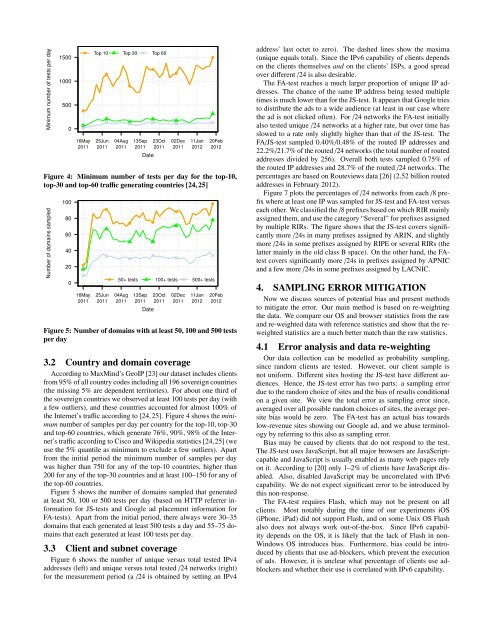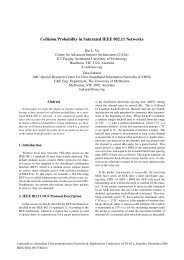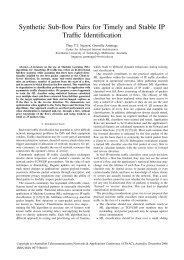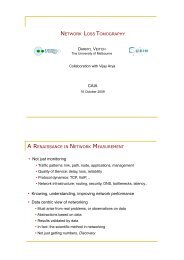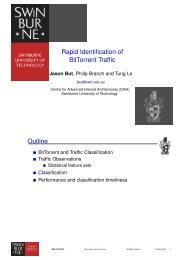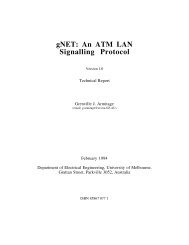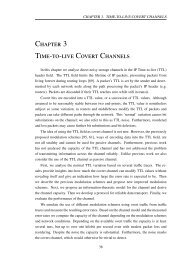Mitigating Sampling Error when Measuring Internet Client IPv6 ...
Mitigating Sampling Error when Measuring Internet Client IPv6 ...
Mitigating Sampling Error when Measuring Internet Client IPv6 ...
Create successful ePaper yourself
Turn your PDF publications into a flip-book with our unique Google optimized e-Paper software.
Minimum number of tests per day<br />
1500<br />
1000<br />
500<br />
0<br />
Minimum number of tests per country per day<br />
●<br />
16May<br />
2011<br />
● Top 10 Top 30 Top 60<br />
●<br />
25Jun<br />
2011<br />
04Aug<br />
2011<br />
●<br />
13Sep<br />
2011<br />
●<br />
Date<br />
23Oct<br />
2011<br />
●<br />
02Dec<br />
2011<br />
11Jan<br />
2012<br />
●<br />
20Feb<br />
2012<br />
Figure 4: Minimum number of tests per day for the top-10,<br />
top-30 and top-60 traffic generating countries [24, 25]<br />
Average number of tests for domains<br />
Number of domains sampled<br />
100<br />
80<br />
60<br />
40<br />
20<br />
0<br />
●<br />
16May<br />
2011<br />
●<br />
25Jun<br />
2011<br />
04Aug<br />
2011<br />
●<br />
13Sep<br />
2011<br />
●<br />
● 50+ tests 100+ tests 500+ tests<br />
Date<br />
23Oct<br />
2011<br />
●<br />
02Dec<br />
2011<br />
11Jan<br />
2012<br />
●<br />
20Feb<br />
2012<br />
Figure 5: Number of domains with at least 50, 100 and 500 tests<br />
per day<br />
3.2 Country and domain coverage<br />
According to MaxMind’s GeoIP [23] our dataset includes clients<br />
from 95% of all country codes including all 196 sovereign countries<br />
(the missing 5% are dependent territories). For about one third of<br />
the sovereign countries we observed at least 100 tests per day (with<br />
a few outliers), and these countries accounted for almost 100% of<br />
the <strong>Internet</strong>’s traffic according to [24,25]. Figure 4 shows the minimum<br />
number of samples per day per country for the top-10, top-30<br />
and top-60 countries, which generate 76%, 90%, 98% of the <strong>Internet</strong>’s<br />
traffic according to Cisco and Wikipedia statistics [24,25] (we<br />
use the 5% quantile as minimum to exclude a few outliers). Apart<br />
from the initial period the minimum number of samples per day<br />
was higher than 750 for any of the top-10 countries, higher than<br />
200 for any of the top-30 countries and at least 100–150 for any of<br />
the top-60 countries.<br />
Figure 5 shows the number of domains sampled that generated<br />
at least 50, 100 or 500 tests per day (based on HTTP referrer information<br />
for JS-tests and Google ad placement information for<br />
FA-tests). Apart from the initial period, there always were 30–35<br />
domains that each generated at least 500 tests a day and 55–75 domains<br />
that each generated at least 100 tests per day.<br />
3.3 <strong>Client</strong> and subnet coverage<br />
Figure 6 shows the number of unique versus total tested IPv4<br />
addresses (left) and unique versus total tested /24 networks (right)<br />
for the measurement period (a /24 is obtained by setting an IPv4<br />
address’ last octet to zero). The dashed lines show the maxima<br />
(unique equals total). Since the <strong>IPv6</strong> capability of clients depends<br />
on the clients themselves and on the clients’ ISPs, a good spread<br />
over different /24 is also desirable.<br />
The FA-test reaches a much larger proportion of unique IP addresses.<br />
The chance of the same IP address being tested multiple<br />
times is much lower than for the JS-test. It appears that Google tries<br />
to distribute the ads to a wide audience (at least in our case where<br />
the ad is not clicked often). For /24 networks the FA-test initially<br />
also tested unique /24 networks at a higher rate, but over time has<br />
slowed to a rate only slightly higher than that of the JS-test. The<br />
FA/JS-test sampled 0.40%/0.48% of the routed IP addresses and<br />
22.2%/21.7% of the routed /24 networks (the total number of routed<br />
addresses divided by 256). Overall both tests sampled 0.75% of<br />
the routed IP addresses and 28.7% of the routed /24 networks. The<br />
percentages are based on Routeviews data [26] (2.52 billion routed<br />
addresses in February 2012).<br />
Figure 7 plots the percentages of /24 networks from each /8 prefix<br />
where at least one IP was sampled for JS-test and FA-test versus<br />
each other. We classified the /8 prefixes based on which RIR mainly<br />
assigned them, and use the category “Several” for prefixes assigned<br />
by multiple RIRs. The figure shows that the JS-test covers significantly<br />
more /24s in many prefixes assigned by ARIN, and slightly<br />
more /24s in some prefixes assigned by RIPE or several RIRs (the<br />
latter mainly in the old class B space). On the other hand, the FAtest<br />
covers significantly more /24s in prefixes assigned by APNIC<br />
and a few more /24s in some prefixes assigned by LACNIC.<br />
4. SAMPLING ERROR MITIGATION<br />
Now we discuss sources of potential bias and present methods<br />
to mitigate the error. Our main method is based on re-weighting<br />
the data. We compare our OS and browser statistics from the raw<br />
and re-weighted data with reference statistics and show that the reweighted<br />
statistics are a much better match than the raw statistics.<br />
4.1 <strong>Error</strong> analysis and data re-weighting<br />
Our data collection can be modelled as probability sampling,<br />
since random clients are tested. However, our client sample is<br />
not uniform. Different sites hosting the JS-test have different audiences.<br />
Hence, the JS-test error has two parts: a sampling error<br />
due to the random choice of sites and the bias of results conditional<br />
on a given site. We view the total error as sampling error since,<br />
averaged over all possible random choices of sites, the average persite<br />
bias would be zero. The FA-test has an actual bias towards<br />
low-revenue sites showing our Google ad, and we abuse terminology<br />
by referring to this also as sampling error.<br />
Bias may be caused by clients that do not respond to the test.<br />
The JS-test uses JavaScript, but all major browsers are JavaScriptcapable<br />
and JavaScript is usually enabled as many web pages rely<br />
on it. According to [20] only 1–2% of clients have JavaScript disabled.<br />
Also, disabled JavaScript may be uncorrelated with <strong>IPv6</strong><br />
capability. We do not expect significant error to be introduced by<br />
this non-response.<br />
The FA-test requires Flash, which may not be present on all<br />
clients. Most notably during the time of our experiments iOS<br />
(iPhone, iPad) did not support Flash, and on some Unix OS Flash<br />
also does not always work out-of-the-box. Since <strong>IPv6</strong> capability<br />
depends on the OS, it is likely that the lack of Flash in non-<br />
Windows OS introduces bias. Furthermore, bias could be introduced<br />
by clients that use ad-blockers, which prevent the execution<br />
of ads. However, it is unclear what percentage of clients use adblockers<br />
and whether their use is correlated with <strong>IPv6</strong> capability.


